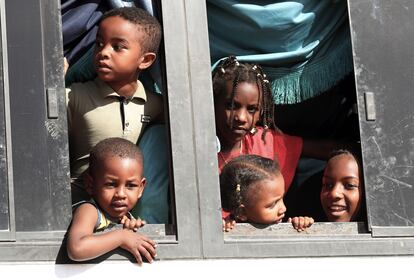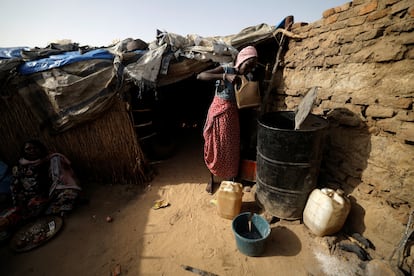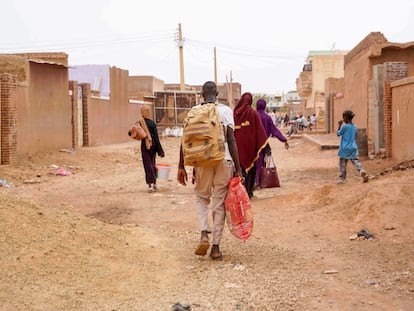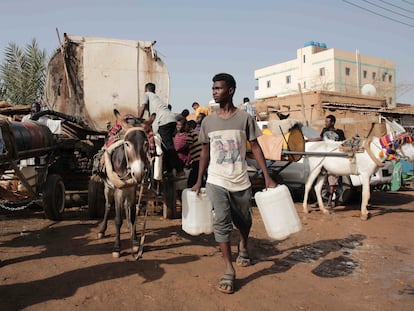The other crises surrounding Sudan
The outbreak of conflict in Khartoum has led to over 385,000 people fleeing to troubled Chad, Ethiopia, South Sudan, Egypt and Central African Republic, all of which were already hosting hundreds of thousands of refugees

On the morning of April 15, a clash erupted in Sudan between the army and the paramilitary Rapid Support Forces (RSF) in a battle for control over the country. Repeated attempts to establish a ceasefire have failed so far. According to the UN, the hostilities have left at least 860 dead and over 5,500 wounded, mainly in the capital Khartoum and in Darfur, in the west, where the FAR have the strongest presence. Nearly three months later, the situation is “heartbreaking” and “desperate,” in the words of the UN High Commissioner for Human Rights (UNHCHR), Volker Türk. The violence has led to 1.2 million internally displaced persons, and the departure of another 385,000 people from the country to Ethiopia, Chad, South Sudan, Egypt and the Central African Republic, according to the UN refugee agency, UNHCR. These nations were already grappling with crises of their own; they were also already hosting large populations of displaced persons and refugees, and most suffer from a severe lack of funding to meet the most urgent needs of those fleeing.
“They still don’t have a sufficient capacity to respond. Now, with the influx of new arrivals, they are at an even greater disadvantage,” explains Peter Kioy, the head of the International Organization for Migration (IOM) mission, on a phone call from Port Sudan on the Red Sea.
According to Kioy, the outlook is bleak. He estimates that many people are still stranded within Sudanese borders as a result of growing insecurity. “To move around, you have to cross numerous checkpoints for both the paramilitary and the army. People are afraid of being harassed by the different armed groups and of being robbed, arrested or beaten,” Kioy explains. For example, according to a UNHCR assessment report, at least a third of the 100,000 people who have crossed into Chad have reported being physically attacked.
Host countries need additional assistance to deal with the new population flows, made up mostly of women and children. They need water, food, shelter, health and psychosocial care and basic relief items, such as blankets, basic hygiene kits, mosquito nets and clothing. “Sudan’s border areas with South Sudan, Chad and the Central African Republic are rural and economically very fragile. This population already needed help before crossing the border, so most of them come without any belongings; they have nothing,” the IOM representative says. UN Secretary-General António Guterres has launched an urgent appeal for $3 billion (€2.8 billion) to help 18 million people across the region. In addition, the imminent start of the rainy season in these regions—which are already heavily damaged by the effects of climate change—portends a worsening humanitarian situation.
South Sudan’s economic dependence
South Sudan is one of the hardest-hit countries in the world; it has been in a constant crisis since it gained independence from Sudan in 2011. Over 2.3 million South Sudanese live outside their country, and another 2.2 million are internally displaced. Before April 2023, a total of around 9.4 million of the population of 12 million needed humanitarian aid amid widespread violence and famine. Despite that situation, it is receiving the most people: according to UNHCR estimates as of June 1, it has received over 90,000 people, most of whom are returnees.
The Sudanese crisis has a much greater impact here because the north of the country depends on Sudan for food, oil and all goods and services. Since the beginning of the conflict, imports have been reduced. “Nothing has been coming in for a month now. The prices of food, gasoline, etc., have more than doubled from what they were on April 15,” explains Marie-Helene Verney, UNHCR’s representative in the country.
And there is another concern there: 90% of the Juba government’s budget comes from oil. The country produces it and sends it through a pipeline to refineries in Sudan, which takes 50% of the revenue. “So far the facilities have not been damaged, probably because none of the parties to the conflict are interested [in doing so], but if anything ever happens to them, South Sudan will be left without resources; [it will have] nothing,” warns Verney.
Of the 17 entry points, Renk, a town in the Upper Nile region in the north that is isolated from the rest of the country, is experiencing the most difficulties. It has been the entry route for 78% of all new arrivals, who have usually made journeys of over 500 kilometers on foot from the last Sudanese city. But Renk lacks infrastructure, services and roads to connect it to the rest of South Sudan. “The only way to get out of there is by plane, but few people can afford it,” says Verney. “Everyone is trying to get boats to cross the river, but the logistics are very complicated and most end up staying for about three or four weeks.”
Meanwhile, the government maintains an open-door policy and facilitates refugee status. This is well-intentioned, but in practice there are no resources: South Sudan has only received 27% of the €644 million it needs.

Egypt grants visas
Egypt’s case is unique because the process of entering the country for Sudanese remains the same as it was before the war: it is governed by a bilateral agreement between the two countries that guarantees freedom of movement, residence, work and property. The country allows free entry to the elderly, children and women, but men between the ages of 16 and 49 require a visa, for which most migrants are applying in Wadi Halfa on the Sudanese side. The process is going very slowly because there is only one consular office to serve everyone concerned. According to recent data from the Foreign Ministry, Egypt had 291,000 refugees in its territory before the crisis in the neighboring country erupted and at least 169,500 people have arrived since the start of the war.
Speaking at the end of a three-day visit to the country to monitor the situation, UN High Commissioner for Refugees Filippo Grandi thanked the government for its “generosity” in keeping the borders open and mobilizing civil society. However, he noted that the pressure and needs are increasing rapidly, and called on international donors, including European countries, to expedite their contributions.
“[Contributions] must be fast-tracked, because how can I tell the governments of Chad, Egypt or South Sudan to accept refugees and treat them well if I can’t offer them anything?” Grandi said, according to Marc Español.
One million refugees in Ethiopia
Mamadou Dian Balde, the UNHCR representative in Ethiopia, visited some European countries last May on a mission to draw attention to a country in the Horn of Africa with several open fronts. Of them, the best known is the armed conflict between the government and the pro-independence Tigray People’s Liberation Front in the north. Two years of war and two million displaced people later, the ceasefire signed in November 2022 has pacified the area, but that did not end the area’s problems. “Ethiopia is hosting almost one million refugees. In 2022 alone, it received over 20,000. People think that when you are in conflict, you close the borders, but Ethiopia kept its doors open,” Balde says.
So far this year, the country has dealt with a new influx of at least 100,000 people from the Somaliland region as a result of internal tensions between the authorities and the local population. Sudan is the second emergency. Since the outbreak of violence in the neighboring country, Ethiopia has received about 7,000 more people, a small figure compared to the numbers they had been handling, but Dian Balde fears that they will not be able to help all of them because so far they have received only 13% of the €385 million they requested to address their needs. The primary need is a place for shelter, but that requires land. “It is not easy to find land because the Dabat area, on the border with Sudan, is very densely populated,” says the UNHCR representative.
At the moment, 88% of the refugees in Ethiopia are housed in 26 camps and settlements. “The best thing would be if people were not forced to flee en masse and those who arrive could be integrated into the cities, where they can have a house and live a normal life. But the reality is that we are going to have to build more camps,” Dian Balde laments.
Chad receives Darfur’s survivors

Chad shares a border with Sudan’s Darfur region, which has been mired in an ethnically tinged internal conflict for two decades; it has left 400,000 dead and two million displaced. The Sudanese are not new to Chadian territory, although the violence led the government to close its entry points. But as is the case elsewhere in Africa, these borders are very porous, poorly guarded and many of them are not even marked; they are no more than an imaginary line in the middle of the countryside, forest or savannah.
So far, in the department of Ade, Chad has received over 100,000 people from Sudan, 90% of whom are women and children, and they are being assisted at registration points set up by IOM and UNHCR in coordination with the government. In recent days, Médecins Sans Frontières (MSF) and local health authorities have treated 72 injured people—most of whom had gunshot wounds—at Adré hospital.
According to MSF, many of those in critical condition have been left behind; they are unable to travel to Chad or access medical care in West Darfur, including in the capital, El Geneina, where violence is particularly intense. “Refugees in West Darfur report very disturbing scenes of violence, with gunmen shooting at people trying to flee on foot, villages looted and wounded people dying. Field hospitals lack staff, equipment and electricity, which affects their ability to function, if they have not already been taken out of commission by the destruction and looting,” says Christophe Garnier, the medical organization’s emergency coordinator in Chad.
Chad also has other open fronts. Its proximity to Nigeria to the east has meant that the Boko Haram terrorist group, which originates from that country, has been making incursions into Chad’s territory for the past eight years, causing significant flows of forced displacement. In total, the country has 1.1 million people who are refugees or displaced persons.
In Central African Republic (CAR), the conflict between the army and various rebel groups, which dates back to 2013 and has no end in sight, has left the country without basic services and infrastructure; there’s no security and it’s a dire humanitarian situation. According to the International Committee of the Red Cross, about one-fifth of the country’s five million people are internally displaced persons or refugees. According to UNHCR, CAR is now also receiving some 13,800 people, including Sudanese and Central African returnees, who arrive through the Am-Dafock border crossing; UNHCR says the new arrivals are staying with host families or have settled in schools and spontaneous camps. Given the fragile security situation, it is proving “extremely difficult” to provide protection for these people, whose most immediate need is food aid, followed by access to basic relief items.
Sign up for our weekly newsletter to get more English-language news coverage from EL PAÍS USA Edition
Tu suscripción se está usando en otro dispositivo
¿Quieres añadir otro usuario a tu suscripción?
Si continúas leyendo en este dispositivo, no se podrá leer en el otro.
FlechaTu suscripción se está usando en otro dispositivo y solo puedes acceder a EL PAÍS desde un dispositivo a la vez.
Si quieres compartir tu cuenta, cambia tu suscripción a la modalidad Premium, así podrás añadir otro usuario. Cada uno accederá con su propia cuenta de email, lo que os permitirá personalizar vuestra experiencia en EL PAÍS.
¿Tienes una suscripción de empresa? Accede aquí para contratar más cuentas.
En el caso de no saber quién está usando tu cuenta, te recomendamos cambiar tu contraseña aquí.
Si decides continuar compartiendo tu cuenta, este mensaje se mostrará en tu dispositivo y en el de la otra persona que está usando tu cuenta de forma indefinida, afectando a tu experiencia de lectura. Puedes consultar aquí los términos y condiciones de la suscripción digital.
More information
Archived In
Últimas noticias
There is as much life left to discover on planet Earth as that which is already known
Dozens presumed dead, around 100 injured in fire at Swiss Alps bar during New Year’s celebration
Is porn for women different from conventional porn? We spoke to those who make it
Cartagena de Indias is sinking: What can the city do to mitigate it?
Most viewed
- Reinhard Genzel, Nobel laureate in physics: ‘One-minute videos will never give you the truth’
- David King, chemist: ‘There are scientists studying how to cool the planet; nobody should stop these experiments from happening’
- Sinaloa Cartel war is taking its toll on Los Chapitos
- Oona Chaplin: ‘I told James Cameron that I was living in a treehouse and starting a permaculture project with a friend’
- The Interoceanic Train, the Mexican alternative to the Panama Canal











































